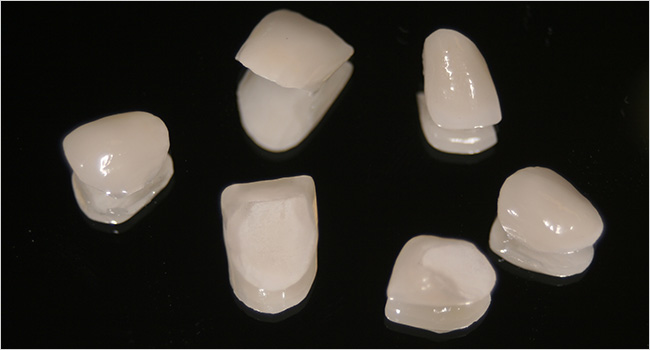Dental veneers (sometimes called porcelain veneers or dental porcelain laminates) are wafer-thin, custom-made shells of tooth-colored materials designed to cover the front surface of teeth to improve your appearance. These shells are bonded to the front of the teeth changing their color, shape, size, or length. Dental veneers can be made from porcelain or from resin composite materials. Porcelain veneers resist stains better than resin veneers and better mimic the light reflecting properties of natural teeth. Resin veneers are thinner and require removal of less of the toothsurface before placement. You will need to discuss the best choice of veneer material for you with your dentist.
What Types of Problems Do Dental Veneers Fix?
Veneers are routinely used to fix:
• Teeth that are discolored — either because of root canal treatment; stains from tetracycline or other drugs, excessive fluoride or other causes; or the presence of large resin fillings that have discolored the tooth
• Teeth that are worn down
• Teeth that are chipped or broken
• Teeth that are misaligned, uneven, or irregularly shaped (for example, have craters or bulges in them)
• Teeth with gaps between them (to close the space between these teeth)
What Are the Advantages of Dental Veneers?
Veneers offer the following advantages:
• They provide a natural tooth appearance.
• Gum tissue tolerates porcelain well.
• Porcelain veneers are stain resistant.
• The color of a porcelain veneer can be selected such that it makes dark teeth appear whiter.
• Veneers offer a conservative approach to changing a tooth’s color and shape; veneers generally don’t require the extensive shaping prior to the procedure that crowns do, yet offer a stronger, more aesthetic alternative.
What Are the Disadvantages of Dental Veneers?
The downside to dental veneers include:
• he process is not reversible.
• Veneers are more costly than composite resin bonding.
• Veneers are usually not repairable should they chip or crack.
• Because enamel has been removed, your tooth may become more sensitive to hot and cold foods and beverages.
• Veneers may not exactly match the color of your other teeth. Also, the veneer’s color cannot be altered once in place. If you plan on whitening your teeth, you need to do so before getting veneers.
• Though not likely, veneers can dislodge and fall off. To minimize the chance of this occurring, do not bite your nails; chew on pencils, ice, or other hard objects; or otherwise put excessive pressure on your teeth.
• Teeth with veneers can still experience decay, possibly necessitating full coverage of the tooth with a crown.
• Veneers are not a good choice for individuals with unhealthy teeth (for example, those with decay or active gum disease), weakened teeth (as a result of decay, fracture, large dental fillings), or for those who have an inadequate amount of existing enamel on the tooth surface.
• Individuals who clench and grind their teeth are poor candidates for porcelain veneers, as these activities can cause the veneers to crack or chip.


